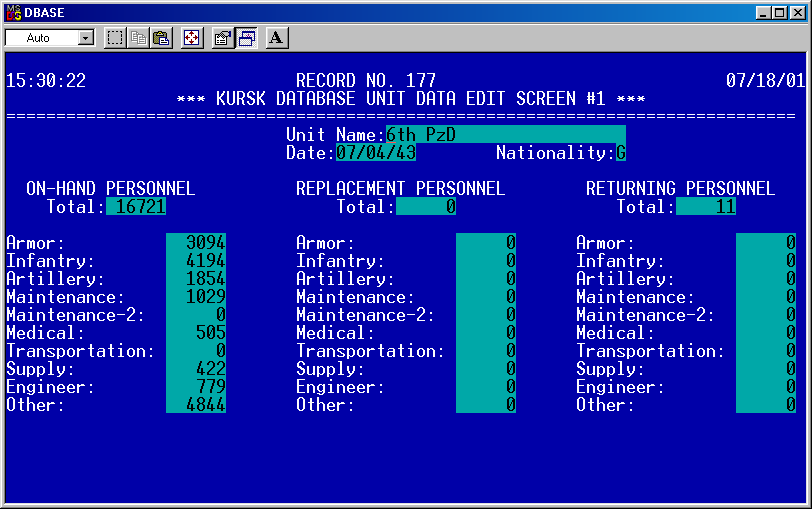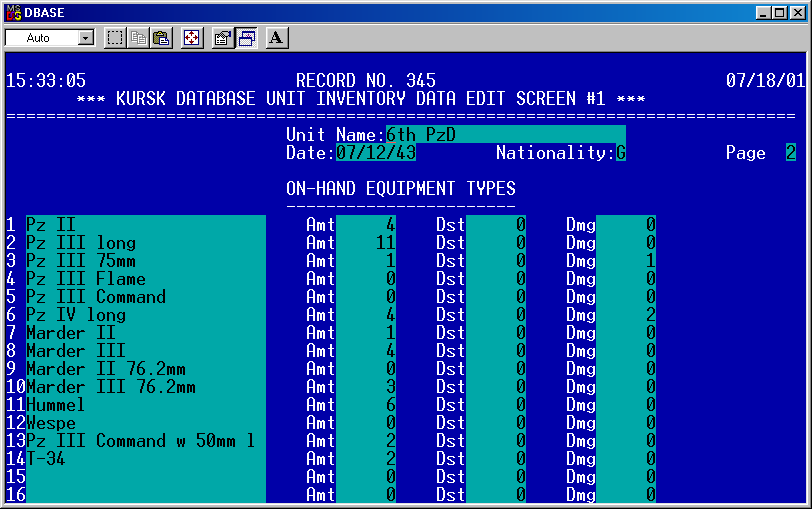
The second large campaign validation database created was the Kursk Data Base (KDB), done 1993-1996. I was also the program manager for this one and it ran a lot smoother than the first database. There was something learned in the process. This database involved about a dozen people, including a Russian research team led by Col. (Dr.) Fyodor Sverdlov, WWII veteran, author and Frunze Military academy; and ably assisted by Col. (Dr.) Anatoli Vainer, ditto. It also involved was the author Dr. Richard Harrison, and of course, Richard Anderson and Jay Karamales. Col. David Glantz helped with the initial order of battle as a consultant.
The unique aspect of the database is that we obtained access to the Soviet archives and was able to pull from it the unit records at the division, corps and army-level for every Soviet unit involved. This was a degree of access and research never done before for an Eastern Front battle. We were not able to access the Voronezh Front files and other higher command files as they were still classified.
The KDB tracked the actions of all divisions and division-sized units on both sides for every day of the German offensive in the south for 4 July 1943 to 18 July 1943. Kursk is a huge battle (largest battle of WWII) and consists of four separate portions. This database covered only one of the four parts, and that part was similar in size to the Battle of the Bulge and the air battle was larger than the Battle of Britain. On the German side were 17 panzer, panzer grenadier and infantry divisions while on the Soviet side were 37 rifle divisions and 10 tank and mechanized corps. There were 9 attacking German armored divisions versus 10 Soviet tank and mechanized corps at the Belgorod Offensive at Kursk. At the Battle of the Bulge there were 8 attacking (engaged) German armored divisions versus 9 U.S. armored divisions. The database design and what data was tracked was almost the same as the Ardennes Campaign Simulation Data Base (ACSDB). The stats on the data are here: http://www.dupuyinstitute.org/data/kursk.htm
The database was programmed in Dbase IV and is DOS based. Dbase IV has the advantage that it allowed text fields. Dbase III did not, so we were limited to something like 256 characters for our remarks fields. With Dbase IV, the remarks fields sometimes grew to a page or two as we explained what data was available and how they were used to assemble daily counts of strengths and losses. Sometimes they were periodic (vice daily) reports and sometimes contradictory reports. It was nice to be able to fully explain for each and every case how we analyzed the data. The Dbase IV version of the KDB is publicly available through NTIS (National Technical Information Service). The pictures in this blog post are screen shots from the Dbase IV version.

We also re-programmed the data base into Access and rather extensively and systematically updated it. This was in part because we took every single unit for every single day of the battle and assembled it into 192 different division-on-division engagements for use in our Division Level Engagement Data Base (DLEDB). This was done over a period of 11 years. We did the first 49 engagements in 1998-99 to support the Enemy Prisoner of War (EPW) Capture Rate Study for CAA (Center for Army Analysis), report E-4 (see http://www.dupuyinstitute.org/tdipub3.htm). Some of the other engagements were done later to support the study on Measuring the Value of Situational Awareness for OSD Net Assessment (Andy Marshall’s shop), reports SA-1. We (meaning me) then finished up the rest of the engagements in 2004 and 2009. In the end we had assembled an engagement record for every single division-on-division level engagement for the Belgorod Offensive. Added to that, in 1999 I began working on my Kursk book, which I had mostly finished in 2003 (but was not published until 2015). So over time, we rather systematically reviewed and revised the data in the database. This is not something we were able to do to the same extent for the ACSDB. The 192 engagements in DLEDB were then summarized as 192 separate “engagement sheets” in my Kursk book. There are also 76 of these engagement sheets available in my new Kursk book coming out in June: The Battle of Prokhorovka. This new book covers the part of the Belgorod offensive centered around the Battle of Prokhorovka.

